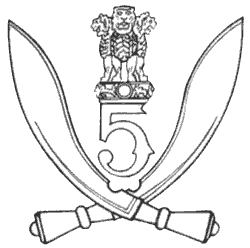Related Research Articles

5th Gorkha Rifles, also abbreviated as 5 GR(FF) is an infantry regiment of the Indian Army comprising Gurkha soldiers of Nepalese origin. It was formed in 1858 as part of the British Indian Army. The regiment's battalions served in the First World War (Mesopotamia) and Second World War.

The 5th Indian Infantry Division was an infantry division of the Indian Army during World War II that fought in several theatres of war and was nicknamed the "Ball of Fire". It was one of the few Allied divisions to fight against three different armies - the Italian, German and Japanese armies.
The 23rd Indian Infantry Brigade was an infantry brigade formation of the Indian Army during World War II from 1941 to at least 1947. The brigade was formed in February 1941, at Loralai in India and in June 1941, assigned to the 14th Indian Infantry Division. In March 1942, the brigade was reassigned to the 23rd Indian Infantry Division, just before being renumbered 123rd Indian Infantry Brigade. As the 123rd the brigade served in the Burma Campaign with not only the 23rd but with the 14th again and the 5th Indian Infantry Division.

The 23rd Infantry Brigade was an infantry brigade of the British Army that saw active service in the First World War, mainly on the Western Front During the Second World War, the brigade saw active service in the Syria-Lebanon Campaign, the Western Desert Campaign, and the Burma Campaign.
The 2nd Indian Infantry Brigade was an infantry brigade formation of the Indian Army during World War II. It was formed in Rawalpindi in September 1939. In October 1940, it was renamed 16th (Independent) Indian Infantry Brigade in November 1941, and left India for Burma. The brigade was caught in the Battle of Sittang Bridge where it suffered heavy losses. Instead of being reformed in September 1942, it was renamed yet again, this time to 116th Indian Infantry Brigade. Attached to the 39th Indian Infantry Division it now provided specialised jungle conversion training. An infantry battalion would spend from four to six months with the brigade, before being sent to the front to replace a tired battalion in one of the fighting divisions.
The 1st Indian Infantry Brigade was an infantry brigade formation of the Indian Army during World War II. It was formed in September 1939, in Abbottabad in India. It was assigned to HQ Rawalpindi District until May 1942, when it joined the 23rd Indian Infantry Division until the end of the war.

The 5th Indian Infantry Brigade was an infantry brigade formation of the Indian Army during World War II. It was converted from the 9th Indian Infantry Brigade in September 1939, and assigned to the 4th Indian Infantry Division. The brigade first moved to Egypt and took part in the early battles in North Africa. Then in 1941, it moved to the Sudan with the 5th Indian Infantry Division. Returning to 4th Indian Division command it took part in the Syria-Lebanon Campaign. The brigade then returned to North Africa coming under command of the 5th and 10th Indian Infantry Divisions, and the 50th (Northumbrian) Infantry Division and the 51st (Highland) Infantry Division in the Campaign in Tunisia. The brigade once more returned to the 4th Division for the Italian Campaign and the Greek Civil War.
The 11th Indian Infantry Brigade was an infantry brigade formation of the Indian Army during World War II. It was relocated from India to Egypt in the middle of August 1939 and trained at Fayed in Ismailia Governorate on the Great Bitter Lake. In October 1939, it was assigned to the 4th Indian Infantry Division. In May 1942, it was attached to the 5th Indian Infantry Division and in June the 2nd South African Infantry Division when it surrendered after Tobruk was captured by the Germans and Italians in 1942. The brigade was then reformed in Egypt in October 1943 and once more assigned to the 4th Indian Division serving in Tunisia, Italy and, at the end of the war, in Greece.
The 32nd Indian Infantry Brigade was an infantry brigade formation of the Indian Army during the Second World War. It was formed in January 1941 in India and assigned to the HQ Western Independent District until April 1942. It was then assigned to the 20th Indian Infantry Division until the end of the war, with short attachments to the 23rd Indian Infantry Division in April 1944 and the 17th Indian Infantry Division from April to July 1944.
The 100th Indian Infantry Brigade was an infantry brigade formation of the Indian Army during World War II. It was formed in April 1920 at Jhansi. The brigade was assigned to the 34th Indian Infantry Division until June 1943, when it was transferred to the 20th Indian Infantry Division until the end of the war. It was known for its participation in Battle of Imphal or known as "Imphal Campaign" where it fought along with other Indian Infantry regiments converged to form the 20th Indian Division and drove back the Japanese Army back to Burma inflicting heavy losses. This was a turning point in the Burma Campaign, part of South-East Asian theatre of World War II.
The 33rd Indian Infantry Brigade was an infantry brigade of the British Indian Army that saw active service in the Indian Army during the Second World War, notably in the Burma Campaign.
The 89th Indian Infantry Brigade was an Infantry formation of the Indian Army during World War II. It was formed in October 1942, at Bhiar Kund in India. The brigade was assigned to the 7th Indian Infantry Division and fought in the Burma Campaign. Apart from between May and June 1944, when it was attached to the 5th Indian Infantry Division, the brigade remained with the 7th Division until the end of the war.
The 63rd Indian Infantry Brigade was an infantry brigade formation of the Indian Army during World War II. It was formed in January 1942, at Jhansi in India and was assigned to the 23rd Indian Infantry Division and served in the Burma Campaign. In March 1942, it was reassigned to the 17th Indian Infantry Division with whom it remained for the rest of the war apart from in May 1942, when it was attached to the 39th Indian Infantry Division.
The 62nd Indian Infantry Brigade was an Infantry formation of the Indian Army during World War II. It was formed in November 1943, and assigned to the 19th Indian Infantry Division The brigade fought in the Burma Campaign and remained with the 19th Division until the end of the war.
The 4th Indian Infantry Brigade was an infantry brigade formation of the Indian Army during World War II. It was formed in September 1939, as the 7th Indian Infantry Brigade and renumbered 4th in June 1940, The brigade was assigned to HQ Rawalpindi District on formation. Then posted to the 26th Indian Infantry Division in April 1942. The brigade also served with the 14th Indian Infantry Division between March and April 1943, and them returned to the 26th Division, where it remained for the rest of the war apart from a short attachment with the 82nd Infantry Division in April 1945.
The 10th Indian Infantry Brigade was an infantry brigade formation of the Indian Army during World War II. It was formed in September 1939. In June 1940 it was assigned to the 5th Indian Infantry Division and in September 1940, sailed for East Africa. The brigade spent time attached to other formations, the 4th Indian Infantry Division between June 1940 and March 1941, and the British 10th Armoured Division between March and June 1942, where it was destroyed during the Battle of Gazala. A new brigade was formed in Egypt and assigned to the 10th Indian Infantry Division, with which it fought in the Italian Campaign from April 1944 until the end of the war.
The 20th Indian Infantry Brigade was an infantry brigade formation of the Indian Army during World War II.
The 21st Indian Infantry Brigade was an infantry brigade formation of the Indian Army during World War II.
The 25th Indian Infantry Brigade was an infantry brigade formation of the Indian Army during World War II. It was formed in February, 1941 at Ahmednagar in India and assigned to the 10th Indian Infantry Division. The brigade was attached to the 8th Indian Infantry Division in August 1941, and took part in the Anglo-Soviet invasion of Iran. Returning to the 10th Indian Division in August 1941, they arrived in the desert just in time for the Battle of Gazala and continued to fight in the Western Desert Campaign and later in the Italian Campaign. While in Italy the brigade was attached to the British 46th Infantry Division from 7 to 11 December 1944.
The 14th Indian Infantry Brigade was an infantry brigade formation of the Indian Army during World War II. The brigade was formed at Attock, now in Pakistan, in October 1940, and assigned to the 7th Indian Infantry Division. In April 1942, the brigade was renumbered as the 114th Indian Infantry Brigade. The brigade fought in the Burma Campaign with the 7th Indian Division and later the 26th Indian Infantry Division.
References
- ↑ "48 Indian Brigade". Order of Battle. Archived from the original on 2007-03-14. Retrieved 2009-10-23.
- ↑ Richard A. Renaldi and Ravi Rikhe, 'Indian Army Order of Battle,' Orbat.com for Tiger Lily Books: A division of General Data LLC, ISBN 978-0-9820541-7-8, 2011, p 161-168
- ↑ "48 Indian Brigade Units". Order of Battle. Retrieved 2009-10-23.
- ↑ Praval Major, K.C. (13 March 2011). "1962 War: The Chinese invasion - III". Indian Defence Review. Retrieved 17 October 2014.